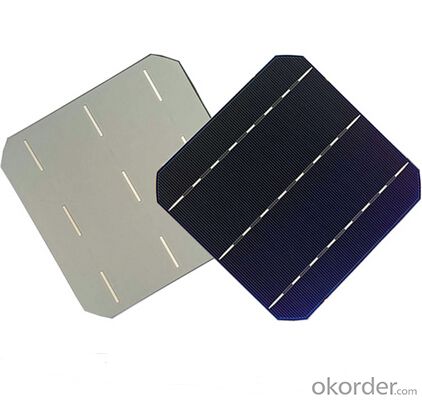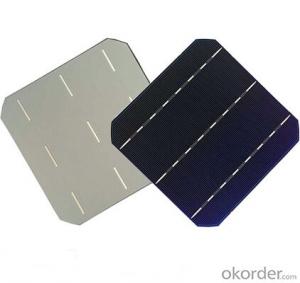Polycrystalline Solar Cell High Quality 17.20%-17.40% Effy
- Loading Port:
- Shanghai
- Payment Terms:
- TT OR LC
- Min Order Qty:
- 1000 pc
- Supply Capability:
- 1000000 pc/month
OKorder Service Pledge
OKorder Financial Service
You Might Also Like
Solar Cells:
Solar cells is made by solar wafer, it has three categories of solar cell right now, monocrystalline polycrystalline and thin film,These cells are entirely based around the concept of PN junction, which is the critical part of solar module, it is the part that can convert the light energy into electricity, the thickness is from 180um to 200um, with even busbars to conduct electricity, textured cell can decrease diffuse reflection; they are often electrically connected and encapsulated as a module. Photovoltaic modules often have a sheet of glass on the front (sun up) side, allowing light to pass while protecting semiconductor wafers from abrasion and impact due to wind-driven debris, rain, hail, etc. Solar cells are also usually connected in series in modules, creating an additive voltage. Connecting cells in parallel will yield a higher current;With high quality and stable quality. Our Cells can greatly improve the performance of Solar Modules.
Solar Cells Advantage:
• High efficiency and stable performance in photovoltaic conversion.
• Advanced diffusion technique ensuring the homogeneity of energy conversion efficiency of the cell.
• Advanced PECVD film forming, providing a dark blue silicon nitride anti-reflection film of homogenous color and attractive appearance.
• High quality metal paste for back surface and electrode, ensuring good conductivity, high pulling strength and ease of soldering.
• High precision patterning using screen printing, ensuring accurate busbar location for ease with automatic soldering a laser cutting.
Specifications
Efficiency Code | 172 | 170 | 168 | 166 | 164 | 162 | 160 |
Efficiency Eff(%) | 17.20-17.40 | 17.00-17.20 | 16.80-17.00 | 16.60-16.80 | 16.40-16.60 | 16.20-16.40 | 16.00-16.20 |
Power Ppm(w) | >4.18 | 4.137-4.186 | 4.088-4.137 | 4.040-4.088 | 3.991-4.040 | 3.942-3.991 | 3.894-3.942 |
Max.Power current Ipm(A) | 7.94 | 7.91 | 7.82 | 7.77 | 7.72 | 7.67 | 7.62 |
Min.Power Current Ipm(A) | 7.73 | 7.68 | 7.58 | 7.54 | 7.49 | 7.44 | 7.39 |
Short Circuit Current Isc(A) | 8.515 | 8.40 | 8.34 | 8.30 | 8.25 | 8.21 | 8.15 |
Max Power Voltage Vpm(V) | 0.522 | 0.520 | 0.519 | 0.516 | 0.513 | 0.511 | 0.508 |
Open Circuit Voltage Voc(V) | 0.624 | 0.622 | 0.620 | 0.618 | 0.616 | 0.614 | 0.612 |
Features:
High efficiencies up to 16.4%
Proven long term mechanical stability of silicone
Make of highly purified poly silicone
Three bus bars for reduced series resistance and improved module and cell efficiency
Blue anti-reflecting coating ensures improved light absorption and increased efficiency
Acid texturization offers a uniform appearance and virtually invisible crystal structure
Excellent low light behavior for improved energy yield

FAQ
We have organized several common questions for our clients,may help you sincerely:
①What price for each watt?
It depends on the efficiency of the solar cell, quantity, delivery date and payment terms.
②How long can we receive the product after purchase?
In the purchase of product within three working days, We will arrange the factory delivery as soon as possible. The pecific time of receiving is related to the state and position of customers.Commonly 7 to 10 working days can be served.
③Can you provide the peripheral products of the solar panels, such as the battery, controller, and inverter? If so, can you tell me how do they match each other?
Yes, we can, we have two companies for solar region, one is CNBM International, the other is CNBM engineering Co.
We can provide you not only the solar module but also the off grid solar system, we can also provide you service with on grid plant.
④What is your warranty of solar cell?
Our product can promise lower than 0.3% open box crack, we support claim after opening the box if it has crackm color difference or sth, the buyer should give pictures immediately, we can not accept the claim after the solar cell has assembled to solar panel.
• Timeliness of delivery
• ⑤How do you pack your products?
We have rich experience on how to pack the solar cell to make sure the safety on shipment, we could use wooden box or pallet as buyer's preference.
- Q:Can solar cells be used for water heating?
- Yes, solar cells can be used for water heating. Solar thermal panels, also known as solar water heaters, use solar cells to convert sunlight into heat energy, which is then used to heat water for various applications such as domestic hot water or space heating.
- Q:How do solar cells handle snow or ice accumulation?
- Solar cells are designed to handle snow or ice accumulation by having a smooth, glass-like surface that allows most of the snow or ice to slide off. Additionally, solar cells generate heat when exposed to sunlight, which helps to melt any remaining snow or ice.
- Q:How is the efficiency of a solar cell calculated?
- The efficiency of a solar cell is calculated by dividing the electrical power output of the cell by the incident solar power input. The formula for efficiency is Efficiency (%) = (Power output / Power input) x 100.
- Q:Are there any subsidies or incentives for installing solar cells?
- Yes, there are subsidies and incentives available for installing solar cells. Many governments and local authorities offer financial incentives such as tax credits, grants, and rebates to encourage the adoption of solar energy. Additionally, some utility companies provide feed-in tariffs or net metering programs, which allow solar system owners to sell excess electricity back to the grid or receive credits on their energy bills. These subsidies and incentives aim to make solar installations more affordable and promote the transition to clean and renewable energy sources.
- Q:Can solar cells store energy for later use?
- No, solar cells cannot store energy for later use as they directly convert sunlight into electricity when exposed to sunlight. However, the electricity generated by solar cells can be stored in batteries or other energy storage systems for later use.
- Q:Can solar cells be used for powering remote military installations?
- Yes, solar cells can be used for powering remote military installations. Solar power provides a reliable and sustainable energy source that can be harnessed in remote areas where traditional power sources are inaccessible or impractical. Solar cells can generate electricity to meet the energy demands of military installations, reducing dependence on fossil fuels and improving operational efficiency. Additionally, solar power systems offer flexibility and can be easily deployed and maintained in remote locations, making them an ideal choice for powering military facilities.
- Q:What is the role of solar cells in powering outdoor lighting?
- Solar cells play a crucial role in powering outdoor lighting as they convert sunlight into electricity. This renewable energy source is harnessed by solar cells installed on outdoor lighting fixtures, allowing them to operate without the need for grid electricity. Solar cells capture sunlight during the day and store the energy in batteries, which is then used to power the outdoor lights during nighttime. This sustainable solution helps reduce carbon emissions, lowers energy costs, and provides reliable lighting in outdoor spaces, even in remote areas where electrical infrastructure may be limited.
- Q:What is the impact of leaf litter on solar cell performance?
- Leaf litter can have a negative impact on solar cell performance as it can block sunlight from reaching the cells, reducing their efficiency. Additionally, if the litter accumulates and covers the cells, it can hinder their ability to convert light into electricity. Regular cleaning and maintenance are essential to ensure optimal solar cell performance.
- Q:Can solar cells be used for powering hotels?
- Yes, solar cells can be used for powering hotels. Solar cells, also known as photovoltaic cells, convert sunlight into electricity, providing a sustainable and renewable energy source. By installing solar panels on the roofs or in open spaces around hotels, they can generate clean energy to meet a portion or even the entire electricity demand of the establishment, reducing reliance on traditional power sources and resulting in cost savings.
- Q:Can solar cells be used for powering hospitals?
- Yes, solar cells can be used for powering hospitals. Solar energy can be converted into electricity by solar cells, and this electricity can be used to power various equipment and systems in hospitals, such as lighting, heating, cooling, and medical equipment. Solar power can provide a sustainable and reliable source of energy, especially in areas with limited access to the grid or unreliable power supply. Additionally, solar energy can help reduce hospitals' carbon footprint and operating costs in the long run.
1. Manufacturer Overview |
|
|---|---|
| Location | |
| Year Established | |
| Annual Output Value | |
| Main Markets | |
| Company Certifications | |
2. Manufacturer Certificates |
|
|---|---|
| a) Certification Name | |
| Range | |
| Reference | |
| Validity Period | |
3. Manufacturer Capability |
|
|---|---|
| a)Trade Capacity | |
| Nearest Port | |
| Export Percentage | |
| No.of Employees in Trade Department | |
| Language Spoken: | |
| b)Factory Information | |
| Factory Size: | |
| No. of Production Lines | |
| Contract Manufacturing | |
| Product Price Range | |
Send your message to us
Polycrystalline Solar Cell High Quality 17.20%-17.40% Effy
- Loading Port:
- Shanghai
- Payment Terms:
- TT OR LC
- Min Order Qty:
- 1000 pc
- Supply Capability:
- 1000000 pc/month
OKorder Service Pledge
OKorder Financial Service
Similar products
New products
Hot products
Related keywords


























